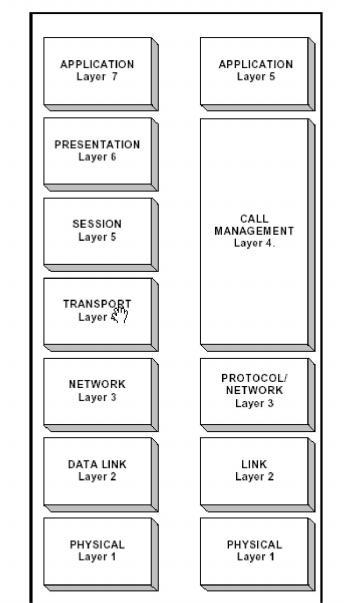
You are here: CSP Developer’s Guide: Overview > 1 Introduction to the Excel Platform > Software Overview

This section is an overview of the Excel platform software, including the following:
• Software layers
• Host/Excel platform communication
• API messages
Host/Excel Platform Communication
Ethernet is the default communications link between the host and the switch.
Communication between the Excel platform and the host is similar to the standard client/server model. In this case, the Excel platform acts as the server and the host acts as the client. Ethernet communication occurs through the stream transport service TCP. The host issues connect requests to the Excel platform before issuing commands.
Excel Application Programming Interface (API) messages are a set of high-level, easy-to-use messages that provide host/Excel platform communication. The host uses the API messages to configure the Excel platform and to perform call processing functions.
Figure 1-3 Communications Mode
l

Excel software is modeled on the standard, seven-layer OSI network protocol stack, but there are important differences between the two. Note that the Call Control layer is a combination of the Presentation, Session and Transport Layers of the OSI network protocol stack, as shown in the figure below:
Figure 1-4 Compare of the OSI stack (left) to Excel software layers

The software layers are shown in the figure below. Call control occurs on the Matrix Controller card and front end protocol processing occurs on the line cards. This distribution ensures accurate, real-time signaling analysis and response within the Protocol/Network layer, with one processor dedicated to 192 ports.
Figure 1-5 Distribution of Excel software layers

Layer 5: Host Applications
The Host Applications layer provides internal or external control for high-level, application-specific call processing such as network call routing, hunting, and queueing. Excel’s high-level application interface lets host applications operate independently of network protocols, so you can develop host applications quickly and easily.
Layer 4: Call Control
The Call Control layer is a combination of the Presentation, Session and Transport Layers of the OSI network protocol stack. The Call Control layer resides on the Matrix Controller card. The host (Layer 5) communicates with the Call Control layer to orchestrate routing, connecting, releasing, parking, and other types of call management.
There are multiple call appearances per channel for flexible call features, such as hold, drop, transfer, conference, and broadcast. The Call Control layer is centralized, so it can also communicate with various network/protocol layers that reside on intelligent line cards.
The Call Control layer also provides network protocol independence to the application layer. Call Control is the default central call processing software for the Excel platform. It is based upon Excel’s Programmable Protocol Language (PPL), and it lets you program advanced call processing applications. Call control is managed through the interaction of the host and the signaling layers within the Excel platform, as shown in Call Control Architecture.
Figure 1-6 Call Control Architecture

Call Control provides the following features:
• Network Signaling Control
• Connection Control
• Call Routing
• Interactive DSP Services Management
• Call Control API Messaging
• Call Duration and Timestamp Reporting for generating Call Detail Records (CDR)
Using Call Control, you can quickly program simplified host applications using unique, programmable call models with different combinations of call routes and control parameters. Call Control supports multiple hosts, and the hosts can all use a single simultaneously.
Call Control offers internal call routing features that support user-defined routing, translation tables, and resource group tables. Resource group management simplifies host applications. It lets Call Control use criteria provided by the host to select an available channel for outseizure. In this way, it relieves the host from maintaining the idle/busy status of channels.
You can use the PPL to customize the default call model. You can also use the PPL to program entirely new call models into the Call Control. And you can use PPL generic data fields to pass additional information to and from Call Control. With the PPL, you can build PBX-like features into the call model to be executed automatically, such as one- and two-way connections, call parking, and call hunting. The entire call model can be downloaded to distributed nodes and implemented in an efficient, reliable, and modular way.
Layer 3 Plus
The Excel Layer 3 Plus binds together layers 3 and 4. Layer 3 Plus resides on smart line cards and converts information from layer 3 into a common message interface. Regardless of the signaling protocol residing on a line card, all communication between layer 3 and layer 4 uses this common message interface. Layer 3 Plus also manages application-specific variants for call control.
Layer 3: Network/Protocol Layer
Layer 3 is the Excel line card Network/Protocol layer. Like Layer 3 Plus, Layer 3 resides on the Excel smart line cards. Layer 3 provides a simple interface to new signaling protocols. With the Programmable Protocol Language and this layered, distributed software architecture, the host can define and download custom protocols for signaling variants. The Network/Protocol layer analyzes in-band and out-of-band signaling control of call setup and teardown for incoming and outgoing calls.
The host can also download multiple Network/Protocol layers to address different network variants.
Figure 1-7 Signaling Architecture

The Link layer transfers signaling data between Layer 1 and Layer 3. The Link layer also performs frame synchronization, retransmission, and flow control, such as robbed-bit signaling, frame alarm control, and Q.921 LAPD functions for the ISDN interface.
The Physical layer provides network electrical interfaces, which include those in the table below:
Table 1-1 Physical network interfaces on Layer
|
Interfaces |
Ports |
Standard |
|---|---|---|
|
2048 |
International Telecommunications Union (ITU) G.707 |
|
|
1536 |
American National Standards Institute (ANSI) |
|
|
J1 |
2048 |
Japan Approvals Institute for Telecommunications Equipment (JATE) |